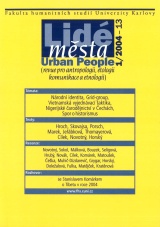Teorie grid-group v politické vědě
Předpoklady, aplikace, kritika
DOI:
https://doi.org/10.14712/12128112.4349Abstrakt
This article offers a critical discussion of the so-called cultural theory, an approach that has evolved within political science as a culturalist alternative to the predominant rational choice models. While the introductory section contains a short overview of the development of cultural theory, the bulk of the article is concerned with its central themes, starting with tbe seminal work of the British social anthropologist Mary Douglas and later focusing on the so far most systematic exposition of this approach in the volume Cultural Theory produced by a circle of authors around the late American political scientist Aaron Wildavsky. The following claims about the nature of social life are highlighted as the basic premises of the cultural theory: 1. societies tend to develop ways of life, i.e. patterns of action and thinking largely congruent with each other. These ways of life are not arbitrary in the sense that it is not possible to combine any values or patterns of thought with any institutions or patterns of behaviour. 2. The ways of life can exist only in viable forms, of which there are at most five instances. At the same time, the viable ways of life mutually support each other and are dependent on each other, with the consequence that there are, in fact, five, not less, viable ways of life. 3. All ways of life are characterised by a set of shared meanings, values and beliefs that form a certain cultural bias. The five ways of life or cultural biases are these: hierarchy, fatalism, individualism, egalitarianism and isolation. The basic theoretical model of ways of life used by cultural theory, the so called grid-group scheme, was developcd by Mary Douglas most notably in her texts Natural symbols and Cultural bias. Douglas' interpretations of both the grid and group dimension are discussed and a shift of emphasis in her interpretation of the grid dimension that occurred between the two aforementioned texts is addressed. The next section deals with the appropriation and creative development of the grid-group approach in cultural theory. Next to the exposition of the basic principles set forth above, attention is paid to the adaptation of the grid-group scheme to the needs of the political science and policy-oriented research. Given the prominent role accorded to preferences in rational choice models, the article discusses Wildavsky's criticism of the premise that preferences are exogenous. His observation is recalled that individuals form preferences on a broad variety of topics, on which they are most likely to possess no detailed knowledge. lndividuals have such a wide range of preferences, because they can "derive" them, obeying a certain cultural logic, from the way of life to which they adhere. In a further section, three examples are given of how, according to proponents of cultural theory, cultural biases shape perceptual frameworks and, through these, also behaviour of individuals. These examples are: views of nature, definitions of what is political and conceptions of social justice. Another salient topic in the cultural theory that is discussed is its theory of change that is frequently considered a weak spot of most culturalist approaches. The article explains the cultural theory position that individuals and groups can change their ways of life because in any society surprises, defined as overt conflicts between what a cultural bias makes one expect and what actually happens, occur and these surprises lead individuals to change their way of life. The permanent flux and interchange of cultural attachments among individuals and groups, which is how Cultural theory represents the social world draws our attention towards another aspect of cultural reality, namely the frequent formation of alliances between different ways of life that helps them obtain competitive advantages in the cultural competition. The concluding section offers a series of critical remarks addressed to the cultural theory: 1. Culture as conceptualised by Wildavsky et al. cannot be used for non-circular explanations of behaviour, since its categories are, in the last analysis, abstractions from observed behaviour. 2. What is called culture is, in fact, the situational context of behaviour, since many of the examples used by the authors are descriptions of situations rather than characterisations of ways of life or cultures. Whereas cultures are rather stable, situations can change abruptly and follow a logic that might have little to do with culture. 3. The grid-group scheme can be criticised even if it is not intended to be used for explanation of behaviour, but solely for its description. The selection of the two dimensions grid and group is arbitrary, the addition of a fifth cultural category, that of isolation or the hermit´s way of life, negates any logic of construction on which the authors insist so much. In spite of these criticisms, however, the article concludes on a reconciliatory note, emphasising the importance of the contribution cultural theory has made to the study of cultural conditioning of social life in general.
Stahování
Publikováno
Jak citovat
Číslo
Sekce
Licence

Tato práce je licencována pod Mezinárodní licencí Creative Commons Attribution-NonCommercial-NoDerivatives 4.0.


